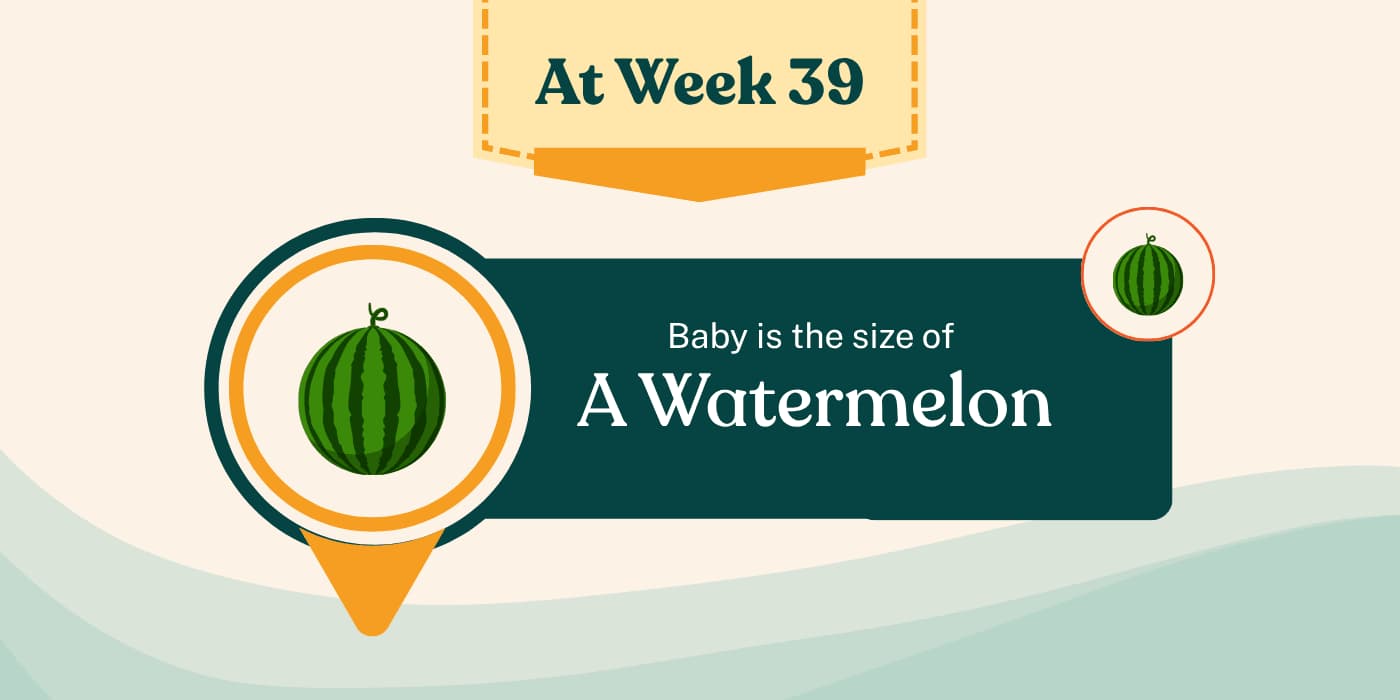Your Pregnancy at Week 39
Science photo library

Written by Mindsmaking Medical Writer
Fact Checked by Mindsmaking Professionals
24th, November, 2025
At 39 weeks pregnant, your baby is preparing for birth. Your body shows signs of labour readiness, such as increased pressure and contractions. It's time to focus on recognising labour and preparing for delivery.
At 39 weeks pregnant, you're in the final stretch of your pregnancy journey, and your baby is almost ready to make their grand debut! At this stage, your baby is about the size of a mini watermelon, measuring around 19.96 inches and weighing about 3288 grams. Your little one is fine-tuning their vital organs, like the lungs and brain, and their skin is now covered in a layer of fat to keep them warm after birth. You might be experiencing some final symptoms as your body prepares for labour, such as increased pressure and mild contractions. What exactly happens at this stage, and what signs should you look out for? How can you best prepare for the big day? Let's see what's happening in your body and how to get ready for your baby's arrival.
Key Takeaways
The brain is still rapidly developing, a process that continues into early newbornhood, but it is developed enough to function properly at birth.
Your baby measures around 19.96 inches and weighs about 3288 grams, comparable to a mini watermelon.
You may experience back pain caused by the baby's head pressing against your spine and increased pressure at the lower part of your bump as the baby settles lower in the pelvis.
The uterus starts very small, weighing about 2 ounces, but has expanded significantly to around 2½ pounds to accommodate the growing baby.
As your body prepares for birth, it relaxes various muscles, including those in the digestive system, which can cause food to move through the intestines more quickly and lead to diarrhoea.
At 39 weeks, it's important to call your doctor right away if you experience severe cramping, a noticeable decrease in your baby's movements or vaginal bleeding.
Although you might find physical activity challenging at this stage, staying active can help you feel better, reducing aches and improving your flexibility.
It's important to discuss with your partner who she would like to have present during the birth of your baby to ensure a comfortable and supportive atmosphere.
Choosing a paediatrician early ensures your newborn receives the best care from the beginning.
Take a peek

Skin changes
The baby's skin has become paler due to a thick layer of fat forming beneath it, essential for temperature regulation after birth.
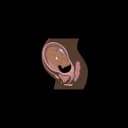
Less space
As the baby grows, there's less room in the womb, so their movements might feel different, but you should still feel them moving frequently.

Brain Development
The brain develops rapidly and continues into the early days after birth. However, it is developed enough to function properly when your baby is born.
Baby Development at Week 39
Your baby, or foetus, is about 19.96 inches long from head to heel, roughly the size of a mini watermelon. Most of the lanugo, the fine hair that once covered your baby's body, has disappeared as they prepare for their final days in the womb.
The skin has taken on a paler appearance due to the thick layer of fat that has formed beneath it. This fat layer is vital for temperature regulation after birth, helping your baby maintain body heat outside. With the baby growing so much, there's now very little room left in the womb. As a result, their movements may feel different or less vigorous than before, but you should still feel them moving just as frequently.
Your baby's lungs are continuing to mature. The production of surfactant, which helps keep the tiny air sacs in the lungs from collapsing, is increasing. This is crucial for your baby's ability to breathe independently once they are born. The brain is still rapidly developing, and this growth continues into the early days after birth. However, these organs are developed enough to function properly when your baby is born. (2)
Mindsmaking
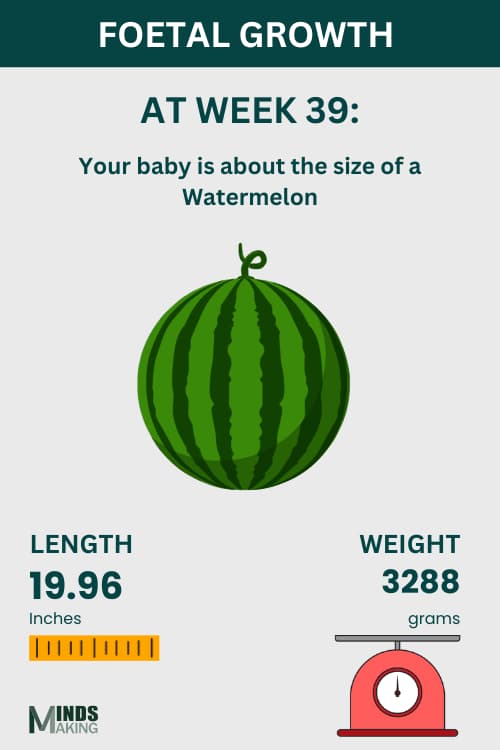
Body Changes at Week 39
As you approach the end of your pregnancy, your cervix undergoes a process called effacement, which is a key part of your body getting ready for labour. Effacement is when the cervix softens, shortens, and becomes thinner to prepare for childbirth. This process happens gradually as your baby moves into the pelvis and closer to the cervix. Your doctor might refer to this process as "cervical ripening" or "cervical thinning," both of which describe the changes in the cervix as it becomes more prepared for labour and delivery. Effacement is essential for the cervix to open up or dilate, allowing the baby to pass through during birth. (1)
You might experience back pain caused by the baby's head pressing against your spine. You will likely feel more pressure at the lower part of your bump as the baby settles lower in your pelvis.
At the same time, you may notice sudden bursts of energy and a strong urge to organise, clean, or prepare your home, such as folding baby clothes or tidying long-forgotten drawers. This is known as the nesting instinct, a natural urge that many expectant mothers experience as they prepare their space for their baby's arrival.
Braxton Hicks contractions, also known as "false labour," may become more noticeable. These contractions can feel as strong and painful as real labour contractions, but unlike true labour, they don't develop a consistent pattern or increase in frequency.
Another sign that labour is approaching is the amniotic sac rupture, commonly called your "water breaking." This can happen in different ways, some women experience a sudden gush of fluid, while others may notice a slow, steady trickle. The water doesn't break for many women until they are well into labour. Sometimes, a healthcare provider may need to rupture the membranes to start or accelerate labour. If you suspect that your water has broken or you are experiencing regular contractions, it's important to contact your healthcare provider right away. (4)
Read This Next
No posts available
Baby Bump At Week 39
As you near the end of your pregnancy, your uterus is reaching its final stage of expansion, which will be completed this month. Initially, your uterus was quite small, weighing around 2 ounces. However, it has grown significantly to accommodate your growing baby and is now about 2½ pounds. This growth is essential to support the baby throughout pregnancy, providing enough space and support for development until birth. Your baby is fully grown and ready to meet you, so you should spend more time admiring your baby bump now, as it will be gone in a few weeks.
Pregnancy Symptoms at Week 39

Mild contractions
At this point in your pregnancy, you may notice some mild contractions as your body prepares for labour. These contractions usually indicate that your cervix is softening and opening, but it doesn't always mean that labour is about to start. Unless your water breaks or the contractions become stronger and more regular, continuing your normal daily activities is best. Early labour, particularly for first-time mums, can be unpredictable and may come and go. Getting too eager or anxious too early can tire you before active labour begins.
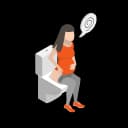
Diarrhoea
As you approach birth, your body starts preparing by sending signals to relax your muscles, which is crucial for the stretching and movement needed during delivery. This relaxation process isn't limited to the muscles involved in childbirth; it also affects your digestive system. Consequently, you might find that food moves through your intestines more quickly than usual, leading to diarrhoea.

Sleep troubles
Getting a good night's sleep at 39 weeks pregnant can be difficult. With your mind racing and various physical discomforts, finding a comfortable sleeping position can feel nearly impossible. If you're already on maternity leave, taking advantage of this time to rest during the day is a good idea. Taking short naps in the afternoon can help you recharge and keep your energy up. Your body needs all the rest it can get at this stage, and a quick nap can be incredibly refreshing and beneficial.
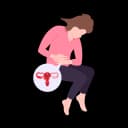
Cervical changes
As your body prepares for delivery, your cervix will soften and become more pliable, a process known as effacement. This means it will begin to thin out and prepare to open. Alongside this, your cervix may also begin to dilate or open to allow the baby to pass through. The pressure from your baby's head pressing against the cervix helps to facilitate this process. During your weekly prenatal exams, your doctor will check for these signs of progress and inform you about how your body prepares for labour.

Pelvic pain
By now, you might be familiar with pelvic pain. Carrying a baby that's now about the size of a watermelon can make this pain even more intense, and by 39 weeks, some women may find it difficult to walk. To manage this discomfort, try to rest and avoid activities that worsen the pain. This can be challenging when you're preparing for a new baby and possibly caring for other children, but it's essential to prioritise your well-being. Avoid heavy lifting, standing or walking for long periods, and any strenuous exercise that might aggravate the pain.
Pregnancy Concerns at Week 39
Since you could go into labour at any moment, it's important to be aware of the signs of labour and keep an eye out for them. You don't have to wait for your scheduled appointment if you have concerns or questions about your pregnancy. At 39 weeks, it's essential to contact your doctor right away if you experience any of the following:
- Severe cramping
- A noticeable decrease in your baby's movements
- Vaginal bleeding
- Intense heartburn
- Changes in vaginal discharge
- Severe headaches or blurry vision
- Fever
- Severe vomiting
- Dizziness or fainting
Health Tips for Pregnancy Week 39
Stay hydrated
Not drinking enough fluids can lead to dehydration, leaving you tired and dizzy. It can also affect your digestive system, potentially causing issues like constipation or irregular bowel movements. Staying well-hydrated is crucial for maintaining your energy levels and keeping your digestive system functioning properly.
Move your body
Although you might find physical activity challenging at this stage, staying active can help you feel better, reducing aches and improving your flexibility. Rather than sitting all day, try walking gently around your neighbourhood, doing light stretches on your living room floor, or enjoying your favourite music while preparing dinner. These simple activities can keep you feeling more comfortable and energised.
Take naps during the day
At this stage, getting long periods of uninterrupted sleep might be difficult due to aches and pains. However, if you can fit in short naps during the day, you can compensate for the reduced nighttime sleep and help recharge your energy. Arrange your pillows to provide the best support for you. Having some white noise in the background, like a fan or soft music, can be helpful. You might also try listening to a relaxation CD or app before bed and practising progressive muscle relaxation.
Change positions slowly
It's important to move carefully to avoid injury. Instead of jumping out of bed or standing up quickly, roll onto your side first and then sit up. If you've been sitting on the couch for a while, stretch your legs before standing. Don't hesitate to ask your partner for help, after all, they're likely happy to assist you at this stage.
Eat smaller meals
Your stomach and digestive organs are compressed by your expanding uterus, making it difficult to handle large meals. To manage this, eating smaller, more frequent snacks throughout the day is perfectly fine instead of trying to eat big meals. Also, avoid spicy foods, as they can exacerbate heartburn and nausea, common issues during the third trimester.
Advice for Partners
As you prepare for the birth of your baby, it's a good idea to talk with your partner about who she would like to have present during the delivery. Ask her if she prefers it to be just the two of you or if she wants the support of friends and family around her. Having this discussion early on allows you both time to make arrangements, such as letting people know if they are welcome or setting clear boundaries if she prefers a more private birth experience. By addressing this now, you can help create a comfortable and supportive environment for her when the time comes.
Pregnancy Checklist for Week 39
- Read up on what to expect from your body after birth. It's normal to still look pregnant after delivery, after all, it took nine months to get here! Understanding the postpartum recovery period can help you navigate these changes.
- Prepare a baby first aid kit and ensure it is fully stocked with essential items. This kit will be crucial for handling minor injuries and emergencies, giving you peace of mind that you're ready to care for your newborn at hom.
- Stock up on after-birth essentials like peri bottles, maxi pads, nursing bras, and postpartum underwear. Hospitals may provide some items, but you'll need your supplies at home for postpartum care.
- Arrange and confirm who will look after your pets and older children when you go into labour and during your hospital stay.
- Make sure you've decided on who will be your baby's paediatrician. This is important to ensure your newborn receives the best care from the beginning.
Frequently Asked Questions
How big is my baby at week 39?
At week thirty-nine, your baby is about 19.96 inches in length. This roughly equals the size of a mini watermelon and weighs about 3288 grams.
Should I worry if I have no signs of labour at 39 weeks?
It might not be what you want to hear. Still, unless there's a medical concern or risk of complications, your healthcare provider is unlikely to worry if you go into your 40th or even 41st week of pregnancy without going into labour. Usually, around 42 weeks, they discuss starting labour with some interventions. If you're not seeing any signs of labour at 39 weeks, it could mean you still have a bit more time to go. However, remember that not all babies give you plenty of notice before deciding to arrive. You might wake up with no signs of labour and end up holding your baby that same afternoon. Newborns can be quite unpredictable!
At 39 weeks, how do I know labour is a few days away?
It can be hard to predict exactly when labour will begin, but watching for signs can help you prepare. Key indicators include your water breaking, noticing that your baby has dropped lower, increased vaginal discharge, and cervical dilation (which your doctor can check). Some women experience labour pains hours or even days before active labour begins, so early signs don't always mean birth is imminent. However, if you observe any of these signs, you must contact your healthcare provider for guidance on the next steps.
How can I tell if it's urine leakage or if my water has broken at 39 weeks?
If your water has broken, the fluid will leak uncontrollably. Depending on where the sac ruptures, it may feel like a sudden gush or a slow trickle. If unsure whether it's amniotic fluid, try sitting down for a few minutes and then standing up. If fluid continues to leak, your water will likely break, and the leaking will persist throughout labour. Amniotic fluid is generally clear and odourless, though it can have a slightly sweet smell and a pinkish tint. Be aware of any foul odours or unusual colours, and contact your healthcare provider if you notice these signs. In contrast, urine has a yellow colour and a distinct ammonia smell. The rupture of membranes might also be accompanied by pressure, a contraction, or even an audible "pop."
Was this article helpful?
How many stars are you giving this article?
Leave a comment
Your email address will not be published.
